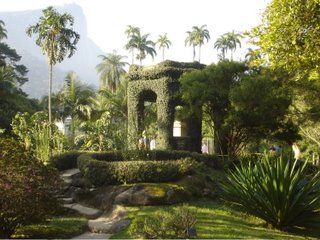First Night in Rocinha
 [no, the picture has nothing to do with Rocinha. but as you'll read, I'm in a good mood and thought something leafy & green from the Jardim Botânico would be nice.]
[no, the picture has nothing to do with Rocinha. but as you'll read, I'm in a good mood and thought something leafy & green from the Jardim Botânico would be nice.]__
So all that negativity from a post back? Forget it, because right after that, just about all of my lobs into the dark came back golden. Shit is on from here out.
Let's start with Rocinha, Rio's largest favela (estimated at 150,000-300,000 residents). Rogerio, from the Fundação Dois Irmãos / Two Brothers Foundations finally got back to me on Tuesday. I called him that afternoon, and, presto: "Do you want to come see a class tonight?" All of a sudden, I was on a bus heading to Rocinha.
If I thought Rio was riotous, then I don't know what to call Rocinha. The entrance alone, a series of stalls called the pasarela, blanket access to the main road up the hill. They have the intensity of a bazaar, crowded & full of jockeying people, selling everything from food & drink to electronics to football jerseys to music -- didn't see any funk on a cursory glance, although I've been told even proibidão (funk that glorifies the drug gangs and as such is banned by the government) can be found there.
Entering Rocinha, I admit I only got a brief glimpse, as the school where the English classes are held was no more than 50 feet in. But it was enough of a glance to create plenty of first impressions. I noticed, for example, the tangles of wires running above the street, described as looking like "postmodern wire sculptures" in one article I read. Legacies of the gatos, those who pirated public services like electricity, they're still there, I imagine, because it doesn't make sense to remove infrastructure, however haphazard, once it's been put up (electric companies have since moved in to offer legal service).
The streets, too, pasarela aside, were a bustle of activity. Bars, lanchenetes, corner stores, kiosks, stalls. It was, all told, a vibrant community.
Compared to Leblon (five minutes -- a tunnel -- a mountain -- and utter separation), the sharpest contrast was definitely in layout. The asfalta (literally "asphalt," meaning middle- and upper-class areas, as compared to the morro, or "hill" of the favelas) is the world of landscaping, gated apartment buildings, 24 hour security, and other obvious luxuries. But it's also the world of right angles. Rocinha, by contrast, meets at any angle that's convenient. Sidestreets barely wide enough for two people to pass. A web as tangled as the wires that crisscross above them.
Convenient, too, that I should see Rocinha for the first time just as I start Edward Said's Orientalism. In the opening chapter, "Knowing the Oriental," he quotes Evelyn Baring, Lord Cromer, England's representatve in Egypt around the turn of the 20th century:
The European is a close reasoner; his statements of fact are devoid of any ambiguity; he is a natural logician, albeit he may not have studied logic; he is by nature sceptical and requires proof before he can accept the truth of any proposition; his trained intelligence works like a piece of mechanism. The mind of the Oriental, on the other hand, like his picturesque streets, is eminently wanting in symmetry.
I obviously don't want to analyze the differences between favela streets and the broad avenues of the wealthier parts of Rio in order to draw the same Orientalist conclusions, but they do reflect certain realities of urban development. The grid structure (which certainly doesn't hold everywhere -- it's plenty easy to get lost downtown) always comes from top-down planning, whether by a surveyor, landowner, or government. Easy to navigate, for commerce and convenience. But the sinuous network of the favela was built from the bottom-up, without land ownership or government planning, designed (or perhaps not designed, but naturally developing) like a code to be understood only by those who live there. Not welcoming to visitors because visitors usually mean bad news (police, rival gangs).
And, moreover, that insider knowledge turns into a tactical advantage, practiced the world over in similarly vulnerable urban communities. A lesson learned by the French during The Battle of Algiers as they tried to penetrate the Casbah (no wonder then, "Bonde de Casbah," the funk track that samples The Clash -- can be heard in Diplo's "Favela on Blast"; will have a stand-alone mp3 soon), Americans in Mogadishu and Baghdad, and police to this day across Rio's hillsides. Politics aside, the moral is the same: Such local communities are not to be fucked with.
So I tread lightly thus far, hope to be able to bring my camera along soon (although Google image search turns up a bundle). Rogerio is taking me to Rocinha's radio station this afternoon, where they broadcast funk, of course. On Friday night I will be going to my first real baile, at Cantagalo, c/o Maga Bo and Adriana Pittigliani (more on her later).

0 Comments:
Post a Comment
<< Home